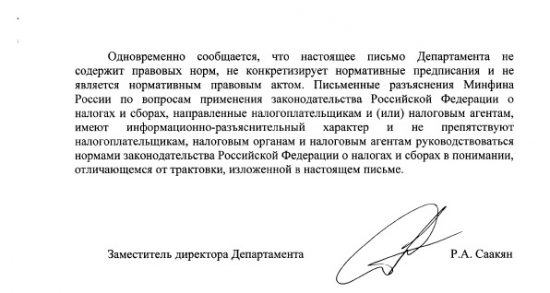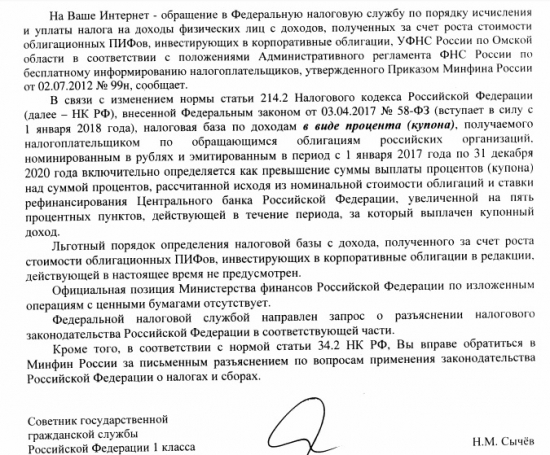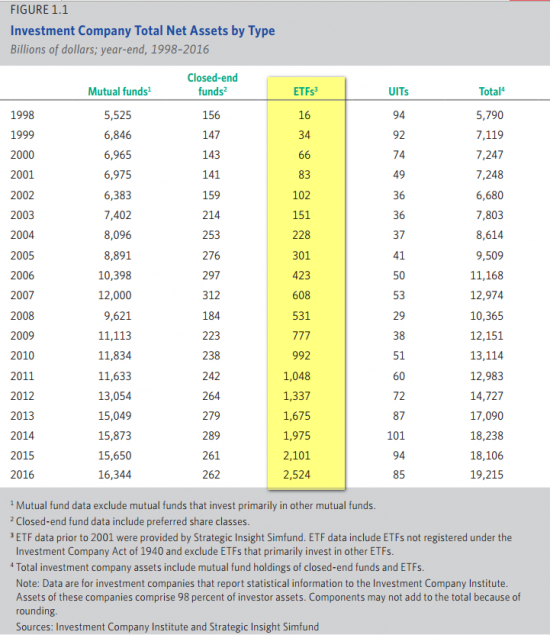пиф
Ещё раз о налогообложении облигаций
- 11 августа 2017, 12:32
- |
И вот Минфин выпустил на эту тему официальное письмо:
"Департамент налоговой и таможенной политики рассмотрел письмо о порядке обложения налогом на доходы физических лиц доходов, полученных по облигациям, не обращающимся на организованном рынке ценных бумаг, и паевым инвестиционным фондам облигаций, в связи с принятием Федерального закона от 03.04.2017 N 58-ФЗ «О внесении изменений в главу 23 части второй Налогового кодекса Российской Федерации» и в соответствии со статьей 34.2 Налогового кодекса Российской Федерации (далее — Кодекс) разъясняет следующее.
Федеральным законом от 03.04.2017 N 58-ФЗ «О внесении изменений в главу 23 части второй Налогового кодекса Российской Федерации» (далее — Федеральный закон) внесены изменения в порядок обложения налогом на доходы физических лиц доходов в виде процентов по обращающимся облигациям российских организаций.
( Читать дальше )
- комментировать
- ★6
- Комментарии ( 1 )
Все что нужно знать о Рентных ПИФах
- 07 августа 2017, 12:14
- |
Цель данной статьи – понять что такое рентные ПИФы и оценить их привлекательность. Перед прочтением также рекомендую ознакомиться с прошлой статьей о ПИФах недвижимости: https://smart-lab.ru/blog/409794.php.
Краткое содержание
Рентных ПИФов мало, они инвестируют в земли, реальная доходность неизвестна, и скорее всего вы уже никогда в жизни их не купите. Дальше, в принципе, можно не читать. Скоро будут статьи про более интересные категории ПИФов. Но если вас все же интересуют подробности этого таинственного инструмента, то можно продолжить.
Что это за инструмент?
Рентный ПИФ – это паевой инвестиционный фонд, инвестирующий в недвижимость. Чем же он отличается от отдельной категории «ПИФов недвижимости»? По сути, только тем, что рентный пиф не может инвестировать средства в строящиеся объекты. На этом значимые отличия заканчиваются. Также как и пифы недвижимости, все рентные фонды – закрытого типа. Это означает что купленные паи можно сдать в управляющую компанию только в конце срока действия фонда — тогда как отрытые пифы можно сдать обратно в УК и забрать деньги в любой момент.
( Читать дальше )
Минфин разъясняет
- 20 июля 2017, 10:37
- |
Сам ответ:


( Читать дальше )
Налоговая разъясняет...
- 23 июня 2017, 13:20
- |

Ситуация неоднозначная, налоговая направила запрос о разъяснении законодательства.
Я тоже отправлю запрос в Минфин.
А у нас ETF, а у Вас? А у нас в квартире газ )
- 18 июня 2017, 11:41
- |
Рассматривая последний отчёт «A Review of Trends and Activities in
the Investment Company Industry» обратил внимание на то какими темпами растут ETF фонды:

Отличие ETF от Mutual Fund приведу с отчёта:
Key Differences
One major difference is that retail investors buy and sell ETF shares on the secondary
market (stock exchange) through a broker-dealer, much like they would any other type
of stock. In contrast, mutual fund shares are not listed on stock exchanges, but are
purchased and sold through a variety of distribution channels, including through investment
professionals—full-service brokers, independent financial planners, bank or savings institution
representatives, or insurance agents—or directly from a fund company or discount broker.
Pricing also differs between mutual funds and ETFs. Mutual funds are “forward priced,”
which means that although investors can place orders to buy or sell shares throughout the
day, all orders placed during the day will receive the same price—the NAV—the next time it
is computed. Most mutual funds calculate their NAV as of 4:00 p.m. eastern time because
that is the time US stock exchanges typically close. In contrast, the price of an ETF share is
continuously determined on a stock exchange. Consequently, the price at which investors
buy and sell ETF shares on the secondary market may not necessarily equal the NAV of the
portfolio of securities in the ETF. Two investors selling the same ETF shares at different times
( Читать дальше )
Страновая и валютная диверсификация портфеля для инвестора - поиск вариантов
- 22 мая 2017, 16:19
- |
Задумался о диверсификации своего портфеля.
Сейчас имею отечественные акции (рублевые), ИИС (корп. облигации) и депозиты, скорее в качестве НЗ, чем инвестиции (особенно доллары и евро при текущих ставках).
Явно требуется диверсификация по стране и валюте.
Критерии: сумма до 10 000, то есть иностранного брокера, к сожалению, сразу не смотрю, так бы вложился в крупные ETF и спал спокойно до поры до времени.
Остальное — собственно предмет для анализа: доходности, затраты по времени, ставкам, налогам.
Стратегия — купить и держать (в основном — дивидендные акции).
Доходы — желательно в валюте.
Ниже первая прикидка вариантов, которые пока нашел, но пока думаю, собираю инфу, в том числе прошу поделиться опытом или советом опытных инвесторов (возможно где-то и ошибся в анализе или недостаточно глубоко копнул). Так же рад ссылкам на почитать/посмотреть.
Спасибо заранее!
Критерии:
Порог входа
Доходность
( Читать дальше )
Важно! Внимание, опрос! Есть ли на Смарт-лабе инвесторы в ПИФы?
- 15 мая 2017, 22:18
- |
Важно! Внимание, опрос! Есть ли на Смарт-лабе инвесторы в ПИФы?
В ПИФах обитает 400 тысяч активных клиентов, а 2,3 миллиона россиян когда-либо пробовали делать это...
Для сравнения, активных брокерских счетов на бирже всего <100 тысяч.
Интересно, есть ли серийные пайщики среди читателей СЛ. Либо это две непересекающиеся вселенные? Другая Россия? :)

Отсюда
ПИФ-ы и ETF могут быть полезны
- 08 мая 2017, 11:13
- |
1) если у меня нет выхода на рынки, где обращаются интересные мне активы
2) если у меня нет денег, что бы зайти во все активы разом в желаемых пропорциях
в этих случаях, ПИФ и, тем более, покупка ETF может быть мне интересна. ETF - рыночный инструмент, мне даже не нужно думать о комиссии за вход и выход, она уже заложена в спред рыночной цены одного пая ETF.
На ММВБ есть возможность покупать ETF, мне давно интересен FinEx Gold ETF (USD). Если меня спрашивают как лучше инвестировать в золото, я просто рассказываю об этом инструменте. Заявлено, что его цена следует за золотом, да ещё и расчёты в долларах — это лайк.
моё новое видео по теме на youtube.
Случай с ПИФ-ом «Биотехнологии» — самый крутой пример из мира ПИФ-ов - Сбербанк за первые 3 месяца привлёк 3.5 млрд рублей в ПИФ, состоящий из одного ETF от BlackRock. Как у них получилось? Думаю, магическое слово: «Сбербанк» + факт, что базовый ETF вырос до этого в 3.5 раза за 4 года и это в $$$. а людей жалко…
Книга о правильном подходе к "вечному" инвестированию
- 07 мая 2017, 07:09
- |
Отмечу, что книга на всем своем протяжении вбивает вам в голову одну мысль: Максимальное сокращение торговых издержек.
ПИФы - активы за 2016 год увеличились на 6% - до 2,835 триллиона рублей
- 04 мая 2017, 13:00
- |
В 2016 год нетто-приток инвестиций составил 148 миллиардов рублей, из них более 140 миллиардов рублей — в сектор ЗПИФов.
В структуре активов фондов существенно выросла доля вкладов в уставные капиталы (+7,9 п.п. — до 17,1%), доля акций российских эмитентов уменьшилась до 15,3% (15,9% на конец 2015 года).
Доля иностранных ценных бумаг в структуре открытых ПИФов сократилась до 27,4% (-16,6 п.п.).
Доля облигаций российских корпоративных эмитентов выросла до 32,5% (+12,2 п.п.)
( Читать дальше )
- bitcoin
- brent
- eurusd
- forex
- gbpusd
- gold
- imoex
- ipo
- nasdaq
- nyse
- rts
- s&p500
- si
- usdrub
- wti
- акции
- алготрейдинг
- алроса
- аналитика
- аэрофлот
- банки
- биржа
- биткоин
- брокеры
- валюта
- вдо
- волновой анализ
- волны эллиотта
- вопрос
- втб
- газ
- газпром
- гмк норникель
- дивиденды
- доллар
- доллар рубль
- евро
- золото
- инвестиции
- индекс мб
- инфляция
- китай
- кризис
- криптовалюта
- лидеры роста и падения ммвб
- лукойл
- магнит
- ммвб
- мобильный пост
- мосбиржа
- московская биржа
- мтс
- нефть
- новатэк
- новости
- обзор рынка
- облигации
- опрос
- опционы
- отчеты мсфо
- офз
- оффтоп
- прогноз
- прогноз по акциям
- раскрытие информации
- ри
- роснефть
- россия
- ртс
- рубль
- рынки
- рынок
- санкции
- сбер
- сбербанк
- северсталь
- си
- сигналы
- смартлаб
- сущфакты
- сша
- технический анализ
- торговля
- торговые роботы
- торговые сигналы
- трейдер
- трейдинг
- украина
- фондовый рынок
- форекс
- фрс
- фьючерс
- фьючерс mix
- фьючерс ртс
- фьючерсы
- цб
- цб рф
- экономика
- юмор
- яндекс


















 Новости тг-канал
Новости тг-канал
